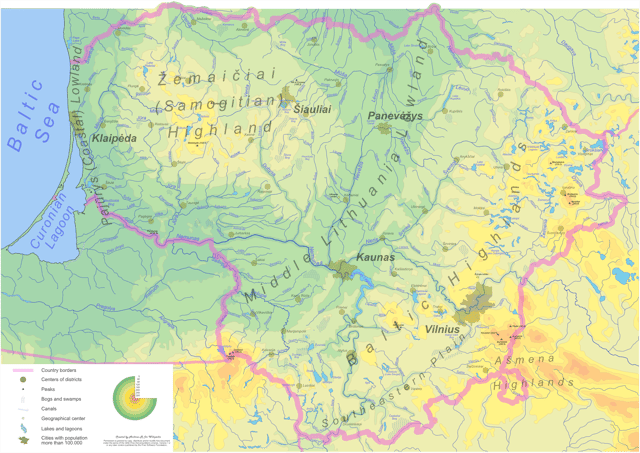Aukštaitija

Aukštaitija

[[INLINE_IMAGE|https://maps.wikimedia.org/img/osm-intl,8,55.57,24.823,400x400.png?lang=en&domain=en.wikipedia.org&title=Auk%C5%A1taitija&groups=_0888c37b81d63d8d02df82355be6917593632aef|undefined||h400|w400]]
Geography

Detailed relief map of Lithuania

Landscape of Aukštaitija
Aukštaitija is in the northeast part of Lithuania and also encompasses a small part of Latvia and Belarus. The largest city and, though not in any strict political sense, the considered capital of the region is Panevėžys, which has over 100,000 inhabitants. The largest cities (by population; those over 20,000 inhabitants) are:
Panevėžys – 119,749 (considered to be capital)
Jonava – 34,954
Utena – 33,860
Kėdainiai – 32,048
Visaginas – 29,554 (note – this city was built by the Soviets and is mainly inhabited by Russians and other Soviet nationalities, therefore it is part of this ethnographic region only geographically)
Ukmergė – 28,759
Radviliškis – 20,339
The region has many lakes, mainly in the eastern side.
History
Historically Aukštaitija had been correspondent to the Duchy of Lithuania up to the 13th century. Its initial capital most likely was Kernavė. In the treaty of Gediminas of 1322, Aukštaitija is named terra Eustoythen ('land of Aukštaitians(=highlanders)'). Aukštaitija was mentioned as Austechia in Chronicon terrae Prussiae written around 1326. Politically, since the end of the 13th century, it comprised the Duchy of Vilnius/Lithuania and Duchy of Trakai, and perhaps was employed to refer to them both taken together. Since the 15th century, corresponding Trakai Voivodeship and Vilnius Voivodeship made up Aukštaitija, as a political and ethnically based unit, also known as Lithuania Propria.
Demographics
Local people mainly speak the Aukštaitian dialect of Lithuanian. Under the new classification of dialects Lithuanian is divided into just two dialects, Aukštaitian and Samogitian with all previous dialects being classified as subdialects. The Sudovian and Dzukian dialects are also considered subdialects of Aukštaitian now, therefore the specific subdialect spoken in Aukštaitija is known as East Aukštaitian.
The region has Russian and Belarusian minorities in the east, subdialects there use more loan words from those languages. However the usage of dialects, as in Lithuania in general, is decreasing.
Symbols

Aukštaitian Coat of Arms

Flag of Aukštaitija
The proposed designs by R. Rinkunas of the Aukštaitian flag and coat of arms were introduced to the public in March 2007.[3]
See also
Aukštaitija National Park
Samogitia